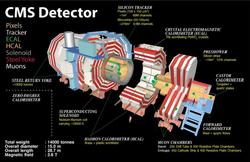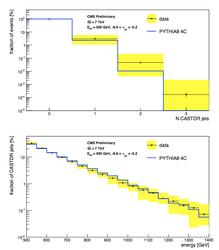CASTOR, acronym for Centauro And Strange Object Research, is a novel sampling, Cherenkov-type calorimeter, located at the very forward region (-6.6 < η < -5.2) of the CMS detector, at the Large Hadron Collider (LHC). Originally designed for the study of Strange Quark Matter (SQM) and the so called Centauro-type cosmic-ray events, the calorimeter serves as an experimental tool for a wide physics program, within the context of forward physics phenomena occurring for both p-p and Pb-Pb collisions at very high energies. Very low-x QCD, underlying events and multiple interactions characteristics, diffraction in the presence of a hard scale, centrality determination and exotic events in heavy-ion collisions, energy flow, as well as constraining cosmic ray shower models are the main physics topics where the CASTOR detector is expected to contribute, mostly.
The measurement of very forward low-pT jets is of primary importance to probe the low-x structure of the proton, with x the fractional momentum of the struck parton with respect to that of the incoming proton. In the low-x region, the strong rise of the gluon density is expected to be tamed by recombination processes, leading to a saturation of the gluon density. The observation of this effect, which is not included in the DGLAP evolution equations, would shed light on the asymptotic high-energy behavior of Quantum Chromodynamics (QCD).
Previous activities: Physics in the very forward region
Previous activities: Physics in the very forward region (with CASTOR)
Present status: data taking finished, analysis in progress.
Compact Muon Solenoid Experiment
Previous activities: Physics in the very forward region (with CASTOR)
Present status: data taking finished, analysis in progress.
At high center-of-mass energy, √s, semi-hard parton interactions with transverse momenta pT much smaller than √s may start to play a substantial role. This high-energy region is supposed to be more appropriately described by the BFKL evolution equations. Events with at least two jets where the most forward and most backward jets have similar low-pT and are widely separated in rapidity (Mueller-Navelet (MN) dijet events) are sensitive to BFKL dynamics for which a stronger rise of the inclusive dijet cross section is expected with increasing rapidity separation between the jets. The azimuthal angle decorrelation of MN dijets is therefore expected to show effects beyond the DGLAP description. The reconstruction of jets in the rapidity region covered by the CASTOR calorimeter, −6.6 < η < −5.2, allows to increase the pseudorapidity separation between the jets by more than 1 unit and to measure jets with transverse momentum pT as low as 3 GeV. A measurement of jets reconstructed in the CASTOR calorimeter is presented to illustrate that the reach of such a kinematic region is a reality at CMS.
The CASTOR reconstruction software provides the following basic objects: the energy per channel and the total energy in each of the 16 φ-sectors, so-called CASTOR towers. Jets in the CASTOR acceptance are reconstructed with the anti-kT jet clustering algorithm with a distance parameter R = 0.7, applied to the collection of CASTOR towers. As the calorimeter has no segmentation in η, all towers are assigned to the same pseudorapidity value η = −5.9, and the jet reconstruction algorithm reduces to a 1-dimensional clustering in φ. As a consequence of the absence of segmentation in η, only the energy spectrum can be measured for jets reconstructed in CASTOR.
The normalized distributions of the jet multiplicity and jet energy spectrum are presented in the figure for jets reconstructed in the CASTOR acceptance, −6.6 < η < −5.2, with an energy E > 500 GeV. The data are compared to the predictions of the Monte Carlo (MC) event generator PYTHIA8 with tune 4C. The error band represents the 22% uncertainty on the absolute energy scale of the CASTOR calorimeter.
CASTOR group members
Kerstin Borras
(project manager)
Phone: +49 (0)40 8998 4488
E-Mail: kerstin.borras@desy.de
Location: 1b / 02.215
Alan Campbell
Phone: +49 (0)40 8998 3461
E-Mail: alan.campbell@desy.de
Location: 1b / 01.233
Merijn van de Klundert
Phone: +49 (0)40 8998 6001
E-Mail: merijn.van.de.klundert@desy.de
Location: 1b / 01.236


